Network Analysis of Outcome-Based Education Curriculum System: A Case Study of Environmental Design Programs in Medium-Sized Cities
Abstract
1. Introduction
2. Review of Related Research
2.1. The Theoretical Basis and Development of OBE
2.2. Limitations and Challenges of Existing OBE
2.3. Innovation and Application of Network Analysis Methods in OBE
3. Data Description
4. Research Method
4.1. Network Construction
4.2. Assessment of Network Centrality Indicators
4.3. Data Standardization
5. Results
5.1. Computer Basics Courses Serve as Critical Hubs and Interdisciplinary Bridges Within Knowledge Transmission Networks
5.2. The OBE Support Network Shows Core–Periphery Structure with Professional Courses as Central Hubs
5.3. Course Network Integration Effects and Optimization Outcomes
5.4. Comparative Analysis of Course Indicators and Statistical Study of Teaching Effectiveness for 3dmaxV and idm (2022–2023)
6. Discussion
6.1. Theoretical Significance and Practical Value of the Core Status of Computer Basics Courses
6.2. Characteristics of the OBE Curriculum System and the Core–Periphery Structure Model
6.3. Overstepping of Teaching Effectiveness in Technical Courses and Its Methodological Implications
6.4. Challenges of Isolation and Integration Strategies for Innovative Practice Courses
6.5. Innovative Applications and Research Contributions of Network Analysis Methods in Educational Assessment
6.6. Research Limitations and Future Directions
7. Conclusions
- The computer basics course plays a crucial hub role in the knowledge transmission network. Network centrality analysis reveals that fundamental computer science courses such as Design Application (Dap) and Professional Knowledge (PK) occupy central positions in the CSCN, exhibiting the highest degree and betweenness centrality, serving as bridges between different disciplinary domains and providing essential knowledge foundations for subsequent specialized courses.
- The OBE curriculum support network exhibits a distinct core–periphery structure. Within the curriculum system, core professional courses occupy critical hub positions, with the PK ranking first with a degree value of 20, establishing it as the most highly connected core node in the network. However, certain courses such as Innovative and Comprehensive Design of Interior Space (Incdois) and Comprehensive Practical Training on Spatial Innovation (cptsi) exhibit isolated states, presenting issues of inadequate connectivity with the main network.
- Teaching effectiveness of technical courses demonstrates significant improvement. The 3DSAMX+VRAY Indoor Digital Environment Design (3dmaxV) course achieved remarkable progress during the 2022–2023 academic year, with average scores increasing from 87.06 to 88.87 points, standard deviation dramatically decreasing from 6.81 to 2.70, and excellence rate rising from to . These improvements fully demonstrate the significant advantages of digital teaching instructional tools.
- Structural differences exist between the CSCN and CTN. The CTN exhibits a relatively flat structural profile, highlighting the temporal sequencing and scheduling of course offerings, whereas the CSCN emphasizes inter-course logical dependencies. Together, these two networks form a comprehensive analytical framework for examining curriculum structure.
Author Contributions
Funding
Institutional Review Board Statement
Informed Consent Statement
Data Availability Statement
Acknowledgments
Conflicts of Interest
References
- Aminah, S.; Alfa Krisnadhi, A.; Nizar Hidayanto, A. Ontological Framework for the Analysis of Outcome-Based Curriculum in Higher Education. IEEE Access 2025, 13, 31497–31516. [Google Scholar] [CrossRef]
- Yuan, J.; Wu, Y. Exploring the Abilities-Cultivation Model for Students in Undergraduate Academies in China. Educ. Change 2024, 28, 16. [Google Scholar] [CrossRef] [PubMed]
- Wu, Z. The Giant Leap in the Development of Higher Engineering Education in China. ECNU Rev. Educ. 2025, 8, 406–424. [Google Scholar] [CrossRef]
- Deng, L.; Li, S.; Zuo, W.; Han, Y. Housing production and the structural transformation of China’s real estate development industry. Hous. Stud. 2025, 40, 1017–1042. [Google Scholar] [CrossRef]
- Wang, L. Machine learning-based environmental art automated design method. J. Comput. Methods Sci. Eng. 2025, 25, 1866–1879. [Google Scholar] [CrossRef]
- Wang, X.; Ning, L. Research on Higher Education Teaching Model Based on OBE. In Proceedings of the 2018 2nd International Conference on Education Science and Economic Management (ICESEM 2018), Xiamen, China, 25–26 August 2018. [Google Scholar]
- Yang, H.; Zhu, H.; Luo, W.; Peng, W. Design and practice of innovative practice workshop for new nurses based on creativity component theory and outcome based education(OBE) concept. BMC Med. Educ. 2023, 23, 700. [Google Scholar] [CrossRef]
- Camur, M.C.; Vogiatzis, C. A survey on optimization studies of group centrality metrics. Networks 2024, 84, 491–508. [Google Scholar] [CrossRef]
- Davis, M.H. Outcome-based education. J. Vet. Med. Educ. 2003, 30, 258–263. [Google Scholar] [CrossRef]
- Tariq, M.B.; Habib, H.A. A Reinforcement Learning Based RecommendationSystem to Improve Performance of Students in Outcome Based Education Model. IEEE Access 2024, 12, 36586–36605. [Google Scholar] [CrossRef]
- Qadir, H.M.; Khan, R.A.; Rasool, M.; Sohaib, M.; Shah, M.A.; Hasan, M.J. An adaptive feedback system for the improvement of learners. Sci. Rep. 2025, 15, 17242. [Google Scholar] [CrossRef]
- Weng, Y.; Zhou, X.; Li, Y.; Gui, H.; Zhou, Q.; Li, W. Illuminating the Palace Lantern: Enhancing High School Students’ Creative Thinking and Problem-Solving Ability Through OBE-STEAM Activities. J. Chem. Educ. 2025, 102, 917–928. [Google Scholar] [CrossRef]
- Rennick, C.; Hulls, C.C.W.; McKay, K.N. Introductory Engineering Decision-Making: Guiding First-Year Students to Relativism in Software Design. IEEE Trans. Educ. 2019, 62, 199–208. [Google Scholar] [CrossRef]
- Zheng, C.Y.; Yang, Y. Progress and application of OBE: A visual bibliometric study based on CiteSpace. In Proceedings of the 2024 2nd International Conference on Information Education and Artificial Intelligence, New York, NY, USA, 20–22 December 2024; pp. 519–525. [Google Scholar]
- Kong, Y.; Wang, W.; Rajabov, B. New model of college physical education teaching based on the algorithm and data structure of flipped classroom and OBE. Heliyon 2024, 10, e31368. [Google Scholar] [CrossRef]
- Xiao, J.; Kanwar, A.; Du, R. The Contribution of Open and Distance Education to Higher Education in China. Open Praxis 2025, 17, 184–202. [Google Scholar] [CrossRef]
- Yuan, X.; Wan, J.; An, D.; Lu, J.; Yuan, P. Multi-method integrated experimental teaching reform of a programming course based on the OBE-CDIO model under the background of engineering education. Sci. Rep. 2024, 14, 16623. [Google Scholar] [CrossRef]
- Zamir, M.Z.; Abid, M.I.; Fazal, M.R.; Qazi, M.A.A.R.; Kamran, M. Switching to Outcome-Based Education (OBE) System, a Paradigm Shift in Engineering Education. IEEE Trans. Educ. 2022, 65, 695–702. [Google Scholar] [CrossRef]
- Wang, Y. Research on the Design of Performance Evaluation System for Physical Education Major Based on Multimedia Information Processing Technology. Int. J. E-Collab. 2024, 20, 1–19. [Google Scholar] [CrossRef]
- Menberu, A.W. Technolog-ymediated financial education in developing countries: A systematic literature review. Cogent Bus. Manag. 2024, 11, 1–38. [Google Scholar] [CrossRef]
- Robinson, S.J.; Yin, M.O.; Ljuhar, D.; McLeod, E.; Pacilli, M.; Nataraja, R.M. A guide to outcome evaluation of simulation-based education programmes in low and middle-income countries. ANZ J. Surg. 2024, 94, 1011–1020. [Google Scholar] [CrossRef] [PubMed]
- Aziz, S.; Wajid, G.; Khan, R.A.; Zaidi, F.Z. Dimensions of challenges in transformation from traditional to integrated modular curriculum - Experiences from Pakistan. Pak. J. Med. Sci. 2023, 39, 1730–1736. [Google Scholar] [CrossRef] [PubMed]
- Gao, Y.; Wu, Y.; Qian, J. Intelligent Multimedia Network Security and PBL Teaching Mode in the Basic Course Teaching of College Design Major. ACM Trans. Asian-Low-Resour. Lang. Inform. Process. 2024, 23, 1–14. [Google Scholar] [CrossRef]
- Erdem, C.; Kaya, M.; Tunç Toptaş, H.; Altunbaşak, İ. Problem-based learning and student outcomes in higher education: A second-order meta-analysis. Stud. High. Educ. 2025, 5, 1–22. [Google Scholar] [CrossRef]
- Peterson, W.J.; Santen, S.A.; House, J.B.; Hopson, L.R.; Wolff, M.; Carney, M.; Cyrus, J.W. Increasing Education Research Productivity: A Network Analysis. West. J. Emerg. Med. 2019, 21, 163–168. [Google Scholar] [CrossRef]
- Koç, A.; Kanadlı, S. Effect of Interactive Learning Environments on Learning Outcomes in Science Education: A Network Meta-Analysis. J. Sci. Educ. Technol. 2025, 20, 681–703. [Google Scholar] [CrossRef]
- Sailer, M.; Maier, R.; Berger, S.; Kastorff, T.; Stegmann, K. Learning activities in technology-enhanced learning: A systematic review of meta-analyses and second-order meta-analysis in higher education. Learn. Individ. Differ. 2024, 112, 102446. [Google Scholar] [CrossRef]
- Wan, Z.; Mahajan, Y.; Kang, B.W.; Moore, T.J.; Cho, J.H. A Survey on Centrality Metrics and Their Network Resilience Analysis. IEEE Access 2021, 9, 104773–104819. [Google Scholar] [CrossRef]
- Kitcher, P. The centrality of education. J. Philos. Educ. 2023, 57, 373–386. [Google Scholar] [CrossRef]
- Putnik, G.; Costa, E.; Alves, C.; Castro, H.; Varela, L.; Shah, V. Analysing the correlation between social network analysis measures and performance of students in social network-based engineering education. Int. J. Technol. Des. Educ. 2016, 26, 413–437. [Google Scholar] [CrossRef]
- Isba, R.; Woolf, K.; Hanneman, R. Social network analysis in medical education. Med. Educ. 2017, 51, 81–88. [Google Scholar] [CrossRef]
- Saghafi, F.; Jalilvand, M.R.; Ahmadiyeh, E.; Nasrolahi Vosta, L. Analysis of an industrial tourism business network using social network approach: The case of Isfahan, Iran. J. Islam. Mark. 2023, 14, 3113–3132. [Google Scholar] [CrossRef]
- Bai, Y.; Zhang, Z.; Chen, T.; Peng, W. Analyst network centrality, forecast accuracy, and persistent influence. Appl. Econ. 2024, 56, 6667–6689. [Google Scholar] [CrossRef]
- Reid, J.W.; Parrish, J.; Syed, S.B.; Couch, B. Finding the Connections: A Scoping Review of Epistemic Network Analysis in Science Education. J. Sci. Educ. Technol. 2024, 2, 133. [Google Scholar] [CrossRef]
- Scott, J. Social Network Analysis: A Handbook, 2nd ed.; SAGE Publications: London, UK, 2000. [Google Scholar]
- Newman, M.E.J. Networks, 2nd ed.; Oxford University Press: New York, NY, USA, 2018. [Google Scholar]
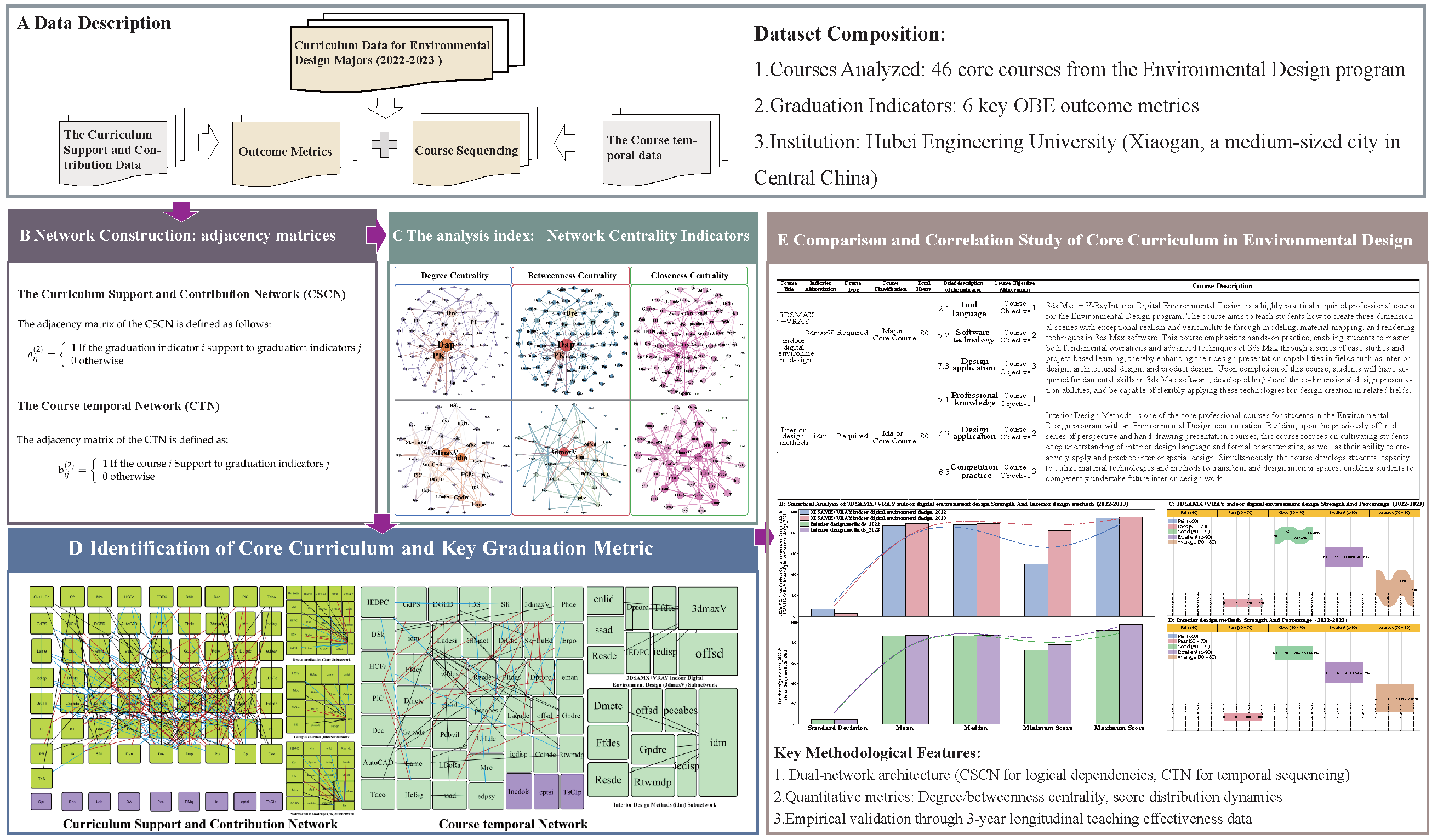
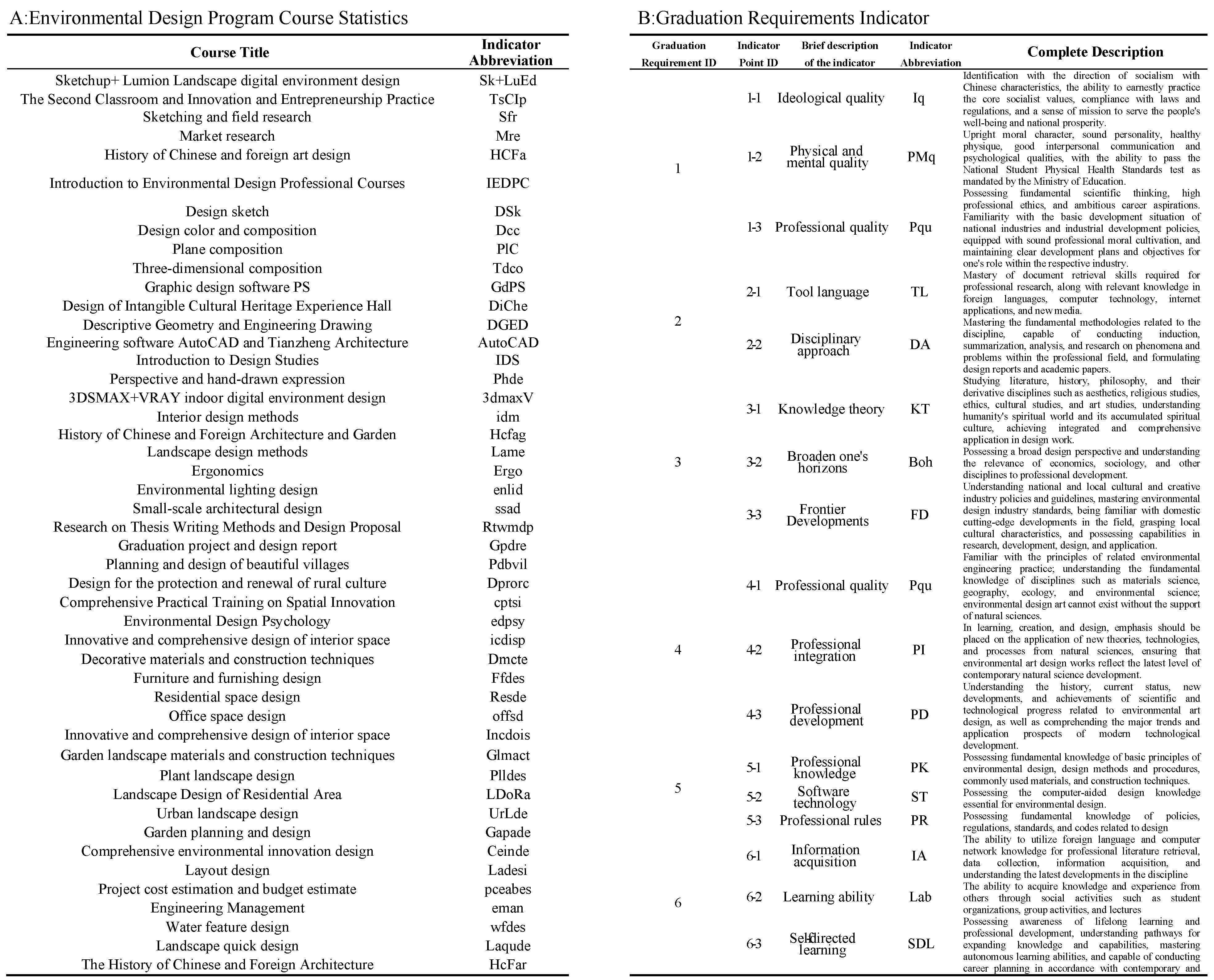
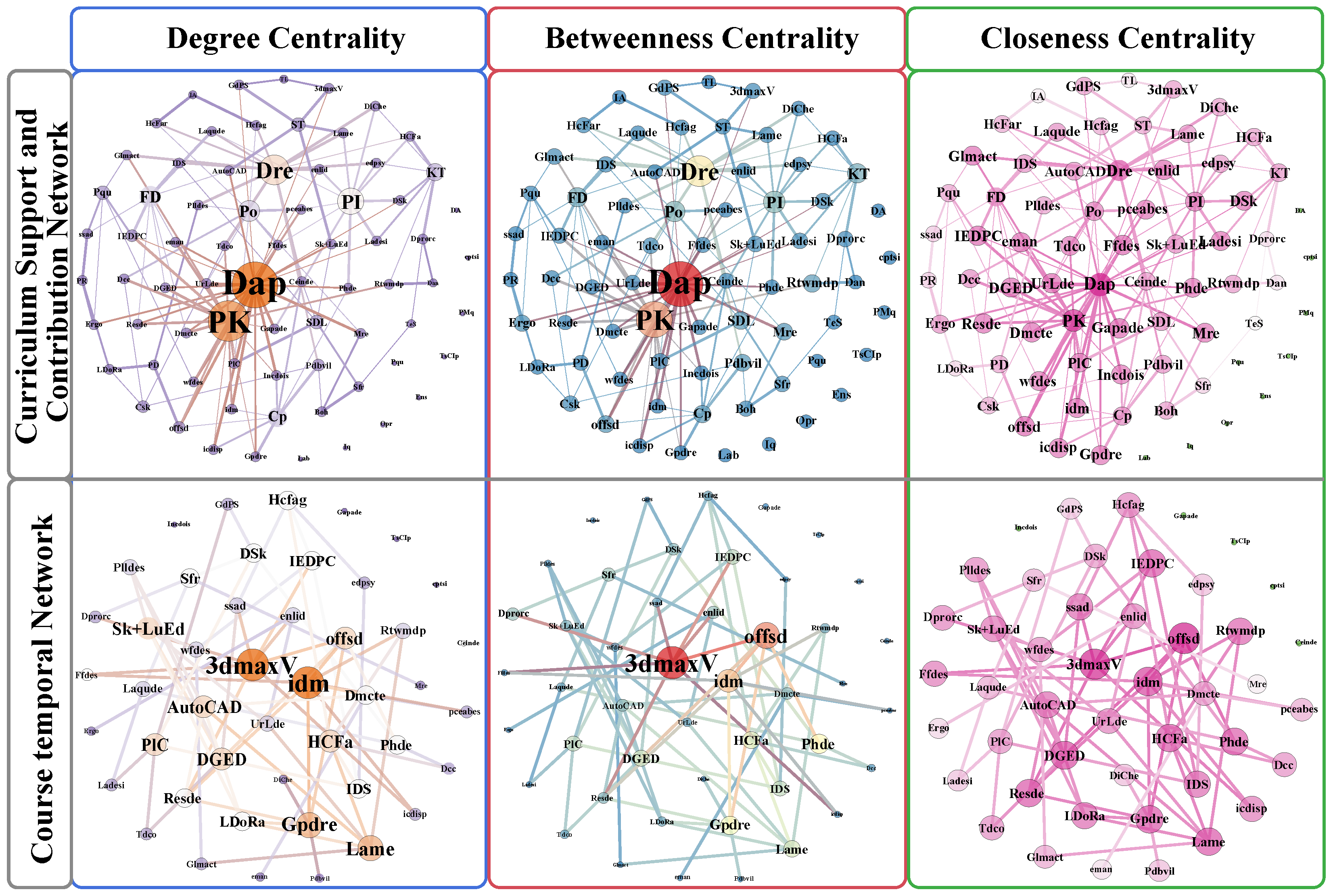
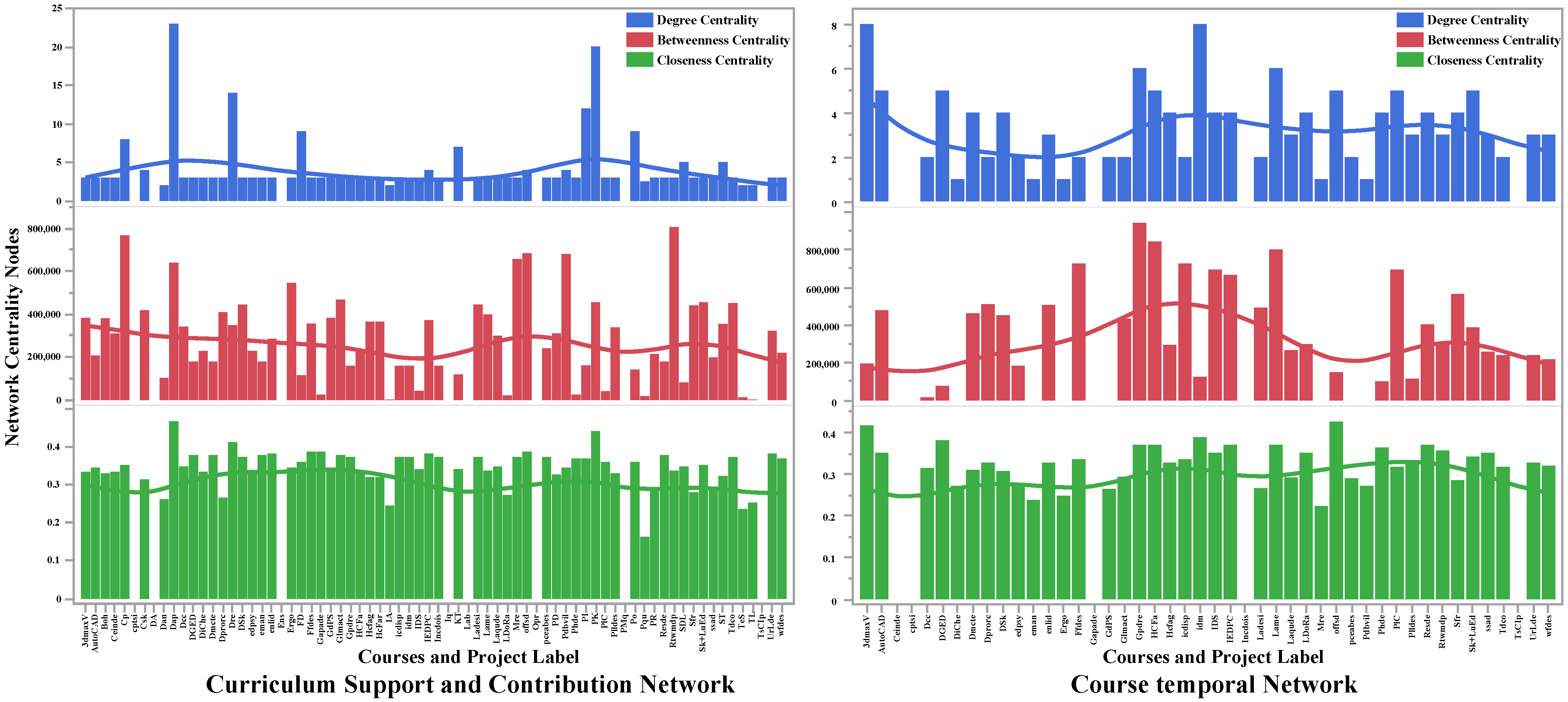
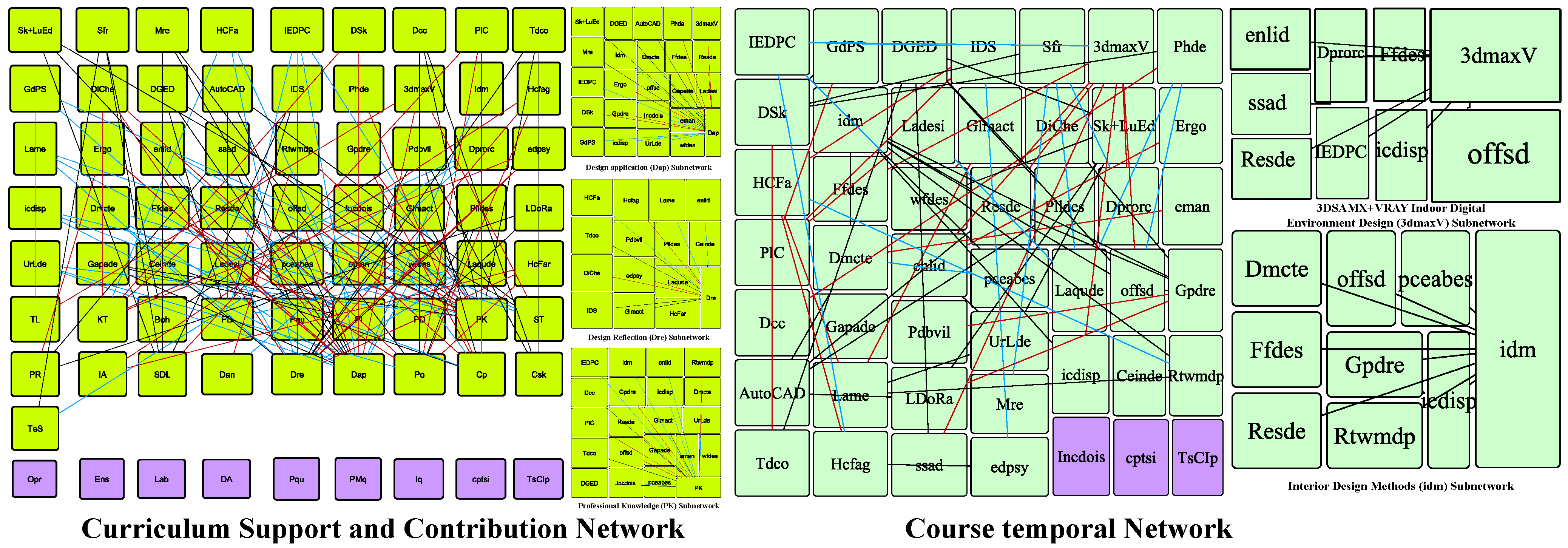
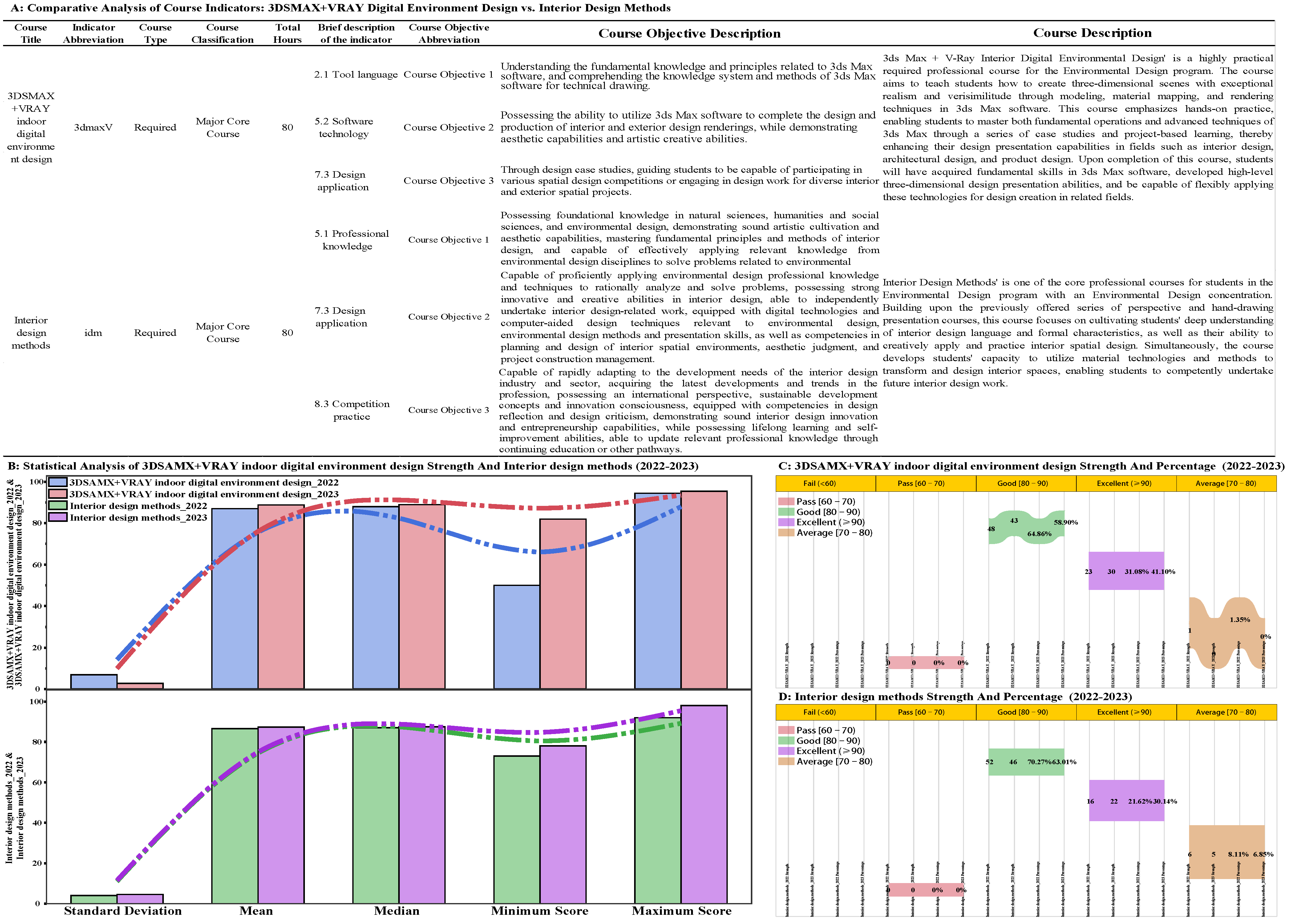
| Name | Formula | Description |
|---|---|---|
| Degree Centrality () | represents an element of the adjacency matrix A, indicating whether nodes i and j are connected. | |
| Closeness centrality () | denotes the total number of shortest paths from course s to course t, and represents the number of shortest paths from course s to course t that through course i. | |
| Closeness centrality () | denotes the shortest path distance from course i to course j. |
Disclaimer/Publisher’s Note: The statements, opinions and data contained in all publications are solely those of the individual author(s) and contributor(s) and not of MDPI and/or the editor(s). MDPI and/or the editor(s) disclaim responsibility for any injury to people or property resulting from any ideas, methods, instructions or products referred to in the content. |
© 2025 by the authors. Licensee MDPI, Basel, Switzerland. This article is an open access article distributed under the terms and conditions of the Creative Commons Attribution (CC BY) license (https://creativecommons.org/licenses/by/4.0/).
Share and Cite
Wang, Y.; Zhan, Z.; Wang, H. Network Analysis of Outcome-Based Education Curriculum System: A Case Study of Environmental Design Programs in Medium-Sized Cities. Sustainability 2025, 17, 7091. https://doi.org/10.3390/su17157091
Wang Y, Zhan Z, Wang H. Network Analysis of Outcome-Based Education Curriculum System: A Case Study of Environmental Design Programs in Medium-Sized Cities. Sustainability. 2025; 17(15):7091. https://doi.org/10.3390/su17157091
Chicago/Turabian StyleWang, Yang, Zixiao Zhan, and Honglin Wang. 2025. "Network Analysis of Outcome-Based Education Curriculum System: A Case Study of Environmental Design Programs in Medium-Sized Cities" Sustainability 17, no. 15: 7091. https://doi.org/10.3390/su17157091
APA StyleWang, Y., Zhan, Z., & Wang, H. (2025). Network Analysis of Outcome-Based Education Curriculum System: A Case Study of Environmental Design Programs in Medium-Sized Cities. Sustainability, 17(15), 7091. https://doi.org/10.3390/su17157091









